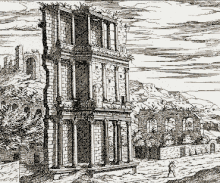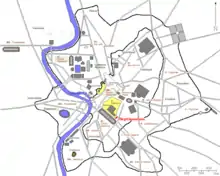Septizonium
Septizonium (myös: Septizodium, Septicodium) oli Septimius Severuksen vuonna 203 Roomaan rakennuttama teatraalinen julkisivu Palatiumin keisaripalatseille Colosseumille johtavan Via Appian alkupäässä lähellä Circus Maximuksen itäistä päätyä.[1] Rakennus muistutti Miletoksen porttia tai roomalaisen teatterin näyttämön taustaseinää (scaena) [2]. Ammianus Marcellinuksen mukaan se oli nymfeille omistettu suihkulähde - nymfeum.


Septizoniumin raunioita käytettiin ensin keskiajalla osana linnoitusta, sitten uudella ajalla kivilouhoksena, jonka lohkareista rakennettiin uutta paavillista Roomaa. Sen viimeisetkin jäännökset, jotka lukuisat renessanssitaiteilijat olivat jo ikuistaneet piirroksiinsa, purettiin 1589, kun paavi Sixtus V valtuutti Domenico Fontanan käyttämään loputkin jäljellä olevasta materiaalista via Quattro Fontanen, via del Quirinalen ja via XX Settembren risteyksen suihkulähteisiin[3].
Lähteet
- Samuell Ball Platner's Topographical Dictionary of Ancient Rome 1929, haettu 9.9.2008 "The inscription (CIL VI.1032, 31229) records the dedication in 203 A.D.; and the building is undoubtedly referred to by Amm. Marc. in 355 (15.7.3: cum plebs excita calore quo consuevit . . . ad Septemzodium convenisset celebrum locum ubi operis ambitiosi nymfaeum Marcus condidit imperator) when the mention of Marcus instead of Severus is due to the fact that the name Marcus appears first in the dedicatory inscription. According to the Vita, therefore, Severus intended this building to serve as a monumental façade at this corner of the hill, visible to all who approached by the via Appia, and also as an entrance to the imperial precinct.."
- Samuell Ball Platner's Topographical Dictionary of Ancient Rome 1929, haettu 9.9.2008 "The design of the front (an ornamental façade with three large niches, and three orders of columns) owed much to the type of permanent stage decoration (scaenae frons) which is seen in the back walls of the stages of various provincial theatres of the Roman period; and it is not without parallels, of which the nymphaea (expressly so called in inscriptions) of Miletus and Side are the most striking."
- There once was in Rome - the Septizonium, haettu 9.9.2008 "A hand-written message by the pope, dated May 23rd, 1589, reads as follows: "Cavalier Domenico Fontana, you shall consign to Muzio Mattei, or to whoever he will indicate, five blocks of peperino marble that have been taken from the Septizonium, which we give to him to be used for the making of his fountains in Strada Felice and Strada Pia", i.e. respectively the present via Quattro Fontane and via del Quirinale-via XX Settembre, in whose corners are the so-called Four Fountains."
Aiheesta muualla
- There once was in Rome - the Septizonium(englanniksi)